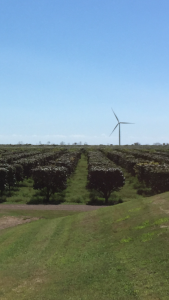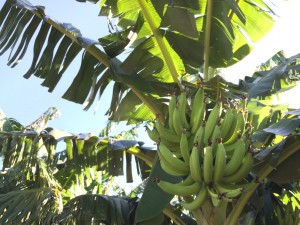For the open house, I envision a walk through, maze-like both with many spaces separated by large sheets that are printed with different panorama pictures. Each panorama will be of a different location. One will be the mountains with the rainforest, another the beach and the coral reefs, and others for the coffee farm and the fruit plantation. We will further enhance the spaces by adding extras such as sand and a coffee plant. In each space there will be a monitor showing video from our experience in the different locations, integrated with or followed by brief educational information about each setting. In between each setting we will have other monitors and/or pictures showing the transitions for each place we visited. Those monitors will have video of the views we saw while in the van, fun music, and pictures of our apartment or Mayaguez. The last section will be discussing the University of Puerto Rico Mayaguez and our project there. The video will show our game, include segments of the interviews we conducted, and discuss our experience as a whole. Once the participants have left the booth we will sum up the experience and answer any questions that they have.
Author Archives: cmptrsn2@illinois.edu
Local realities of global issues
Global climate change is uniquely affecting all places around the world. Living in Illinois, I can conceptualize the causes of climate change and read about the s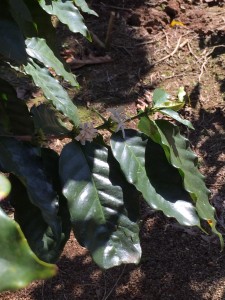 evere weather events occurring around the world, and I can detect that the seasonal variations are not quite the same, but I cannot truly understand the gravity of the effects of climate change until I hear about them first hand from those experiencing them and suffering their consequences.
evere weather events occurring around the world, and I can detect that the seasonal variations are not quite the same, but I cannot truly understand the gravity of the effects of climate change until I hear about them first hand from those experiencing them and suffering their consequences.
Visiting Puerto Rico, I had that eye-opening experience. At the small family owned coffee farm in Puerto Rico, Café Gran Batey, the owner’s son reflected on climate change causing significant reductions in coffee yields with the this year and last year their lowest coffee yields on record. Yield has drastically decreased because of changes in a climatic pattern essential for coffee growing.
Puerto Rico has a dry season and a wet season. In the early months of the year, the dry weather allows for the coffee plant flowers to open and be pollinated. Then, in the later months of the year, the wet weather is essential for the coffee bean to grow and hold in moisture. However, climate change has flip flopped the seasons. More rain at the beginning of the year is knocking off the flowers and not allowing them to open for pollination. Less rain at the end of the year is producing coffee beans with dry centers.
The truth of the owner’s son concern about climate change became even more evident in the storage room where there were few bags filled with coffee beans compared to the amount of space available. Making the connection between the weather causes and the almost empty storage room, I reflected further on society’s dependence on agriculture for goods, and the potential extent of economic 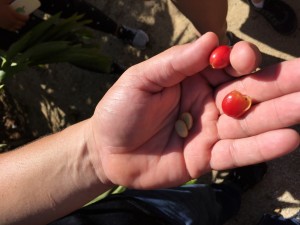 and food availability consequences for producers and consumers.
and food availability consequences for producers and consumers.
The severity of climate change and its effects on agriculture, however, did not discourage me. Instead it reaffirmed for me that solving global issues in agriculture would require developing dynamic regional solutions for regional climatic and agricultural variations.
Before coming to Puerto Rico, I was curious to find out the status of conservation, including their methods of conservation and how much land is protected. At El Yunque National Forest, I was happy to find that their educational materials discussed the interdependency of different species in an ecosystem and of people on ecosystems. Then, at Hacienda Buena Vista, I was impressed by their mission to preserve biodiversity and historical sites and their ideal of susta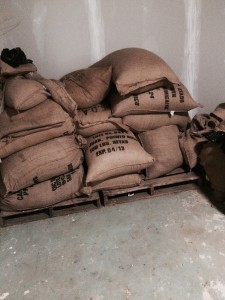 inable agriculture as well as their focus on education.
inable agriculture as well as their focus on education.
All of my questions about Puerto Rico’s status on conservation and sustainability have yet to be answered. I want to find more quantitative data about energy, recycling, and biodiversity that my observations cannot provide. My observations still have allowed me to reflect on global sustainability, especially when comparing Illinois with Puerto Rico. From my experience in Illinois, I know that it is still developing in many areas of sustainability, and much work as well as research needs to be done to both implement and improve programs. Puerto Rico is in the process of development too. Puerto Rico has showed me further that all places around the world are at different stages of achieving sustainability and that achieving sustainability will require collaborative effort from all fields on a local level.
With a few more days left in PR, I am anxious to ask more questions and experience more of the island. I am especially excited to ask students at the University of Puerto Rico-Mayaguez about their perspectives on sustainability, and, having enjoyed PR so much myself, I am curious to know what they especially like about the island.
Questions of Sustainability in Puerto Rico
One located in the tropical south; one, in the temperate north. Rain forests and coral reefs cover and sur round one while prairies and woodlands spot the other. One, mountainous; the other…flat. One grows coffee and fruits; the other, corn and soybeans. Puerto Rico and Illinois, they seem vastly different with the vast distance between them, and in most respects, they are; however, the nature of the sustainable agriculture issues that they face—socially, economically, and environmentally—are the same.
I began to recognize the complexity of the issues facing Puerto Rico, especially in agriculture, when we visited Café Gran Batey, a small family coffee farm, but the social, political, and environmental context became more defined when we visited Martex, a larger scale fruit plantation. Since the business produces high quantities of products, greater challenges in terms the cost of employment and energy arise, so current economics and policy more intimately effect the profit and production of the plantation.
For example, the cost of energy remains very high in Puerto Rico because only a few businesses or the government own the energy sources, and the rest of the energy has to be imported. In order to curb energy costs, the plantation has made various installations of solar panels. However, the plantation only installed solar panels when there were government grant programs or other subsidies, so while solar panels provide clean, renewable energy, they were only installed when economically practical for the business. Thus, sustainability on a large scale requires not simply environmental viability with energy sources that do not pollute and can be continually renewed, but economic viability with businesses that maintain profits and provide people with the products that they need.
Further considerations arise for large scale production when managing pests and other plant diseases to ensure a quality product that consumers are willing to buy. Although pesticides are detrimental to the environment and potential cause unforeseen harms to both other species and the environment, they ensure that large losses do not occur because of certain fungi or insects, and they ensure that the costumer will be willing to buy the product. The owner provided me with one example when he discussed a specific insect that made little holes on plantain peels. The insects caused no harm to the edible part of the plantain, but consumers would not buy a plantain that appears damaged and unsafe to eat.
Beyond pesticides, dominate concerns of the plantation are nutrient runoff, soil erosion, and greenhouse gas emissions. The University of Puerto Rico-Mayaguez is helping the farm specifically decrease emissions by carrying out experiments that test the quantity and quality of soil emissions when different methods of fertilization are used. An example of how methods of increasing production need to be balanced with environmental impacts, and in this case, how new technology and research can help farms find that balance.
The large scale plantation, with thousands of acres in production and that uses pesticides, contrasts directly with the ideal of the first small coffee farm that we visited, Hacienda Buena Vista, which promoted an organic method of farming that promoted incorporating farming into the rain forest ecosystem to conserve land and to protect biodiversity. Comparing and contrasting the farming methods certain questions come to mind. Can small production farms provide people with sufficient resources? What are the environmental impacts of a large scale plantation? Can a medium be reached between the two methods of agricultural production?
Illinoisans are asking the same questions. We too have small organic farms that wane in comparison to the enormous corn and soybean operations. Our large scale farms contribute significantly to nutrient pollution and emissions. The solutions lie in close research that can determine the farming methods that can minimize the environmental impacts while providing people with necessary resources and ensuring long-term economic stability for farming operations.
Wherever we go around the world, we will find agriculture and other industries in the same three circled sustainability Venn diagram, attempting to reach the center where people benefit, business grows, and the environment sustains itself. Coming to Puerto Rico, I more wholly understand the intimate relationship between the three themes of sustainability. If the environment is not protected in the long term, economic growth cannot be maintained. If the economy does not grow, the people suffer the consequences.
I’m excited to learn more and visit more places so that I can better understand how we can reach that equilibrium.
Chelsea Peterson Test Post: My Role
Hola, mi nombre es Chelsea! I am a freshman in Agricultural and Biol ogical Engineering, and I am excited to be on a study tour in Puerto Rico! My main contribution to the project will be finding research to support the information that we are sharing with our poster booth. Our poster booth’s effectiveness depends on what our audience can learn and understand, so I will help organize the information in a logical, understandable order and make sure that our posters and supporting materials reflect the conversation that we will be having.
ogical Engineering, and I am excited to be on a study tour in Puerto Rico! My main contribution to the project will be finding research to support the information that we are sharing with our poster booth. Our poster booth’s effectiveness depends on what our audience can learn and understand, so I will help organize the information in a logical, understandable order and make sure that our posters and supporting materials reflect the conversation that we will be having.


